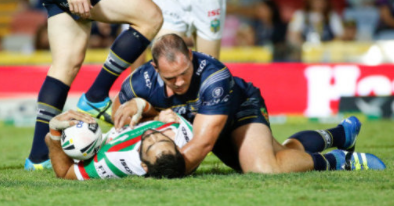Concussion in sport: Five sports gather to discuss head-injury prevention

Medics from five sports have met to work out a “unified approach” to tackling concussion and head injuries.
Representatives from rugby union, rugby league, American football, ice hockey, and Australian rules football met in Dublin on Thursday.
Earlier this year a panel of experts suggested ways to address what is becoming a growing issue in sport.
Thursday’s meeting was aimed at looking into how best to put those recommendations in place.
“Concussion is a top priority for all sports, and rugby continues to collaborate with other sports and leading medical and scientific experts to ensure the very best programmes are implemented to protect participants at all levels,” said World Rugby chairman Bill Beaumont.
Several recommendations were put forward in April by the Concussion in Sports Group (CISG), a panel of experts which draws on data and research to come up with suggested ways forward.
“While providing consensus guidance of what sports should do, it does not offer guidance on how to implement its recommendations, which is why sports are keen to collaborate,” a World Rugby spokesperson said.
Why is concussion an issue?
In 2016, some 5,000 former American football players successfully sued the NFL for $1bn (£700m), claiming it hid the dangers of repeated head trauma.
In March, three Australian National Rugby League sides were given record fines for breaching concussion protocols and Uefa recently has commissioned a research project to examine the links between dementia and playing football.
Rugby’s concussion reviews are ‘not fit for purpose’ and the sport is becoming ‘unplayable’, according to a leading expert.
In January, World Rugby introduced heavier sanctions for high tackles in an attempt to lessen the incidence of concussion in its sport.
Law amendments to be trialled
World Rugby, meanwhile, has approved the addition of six law amendments around the scrum and ruck for a global trial in a bid to make the game easier to play and referee. Some of the changes will also address player welfare, the governing body hopes.
The changes will be trialled in the northern hemisphere from 1 August and extended to the southern hemisphere from 1 January and will include the end-of-year internationals in Europe.
The law changes are:
- All members of the front row can to attempt to ‘strike’ for the ball after it has been put into the scrum
- The number eight at the back of the scrum may pick up the ball at the feet of the locks, rather than wait for it to make its way to between his legs
- The scrum-half may now stand with their shoulder aligned to the middle of the scrum, allowing them to be further to their side of the set-piece
- Players on their feet at the ruck will now be able to pick up the ball on the floor as long as no opposition player has joined the ruck
- If the ruck has resulted from a tackle, the tackler must get to his feet before he can play the ball, and must do so from his side of the contest, through the ‘gate’ and not from the side as they could previously
- Players may also no longer kick the ball out of a ruck, but can ‘hook’ it back towards their own side
